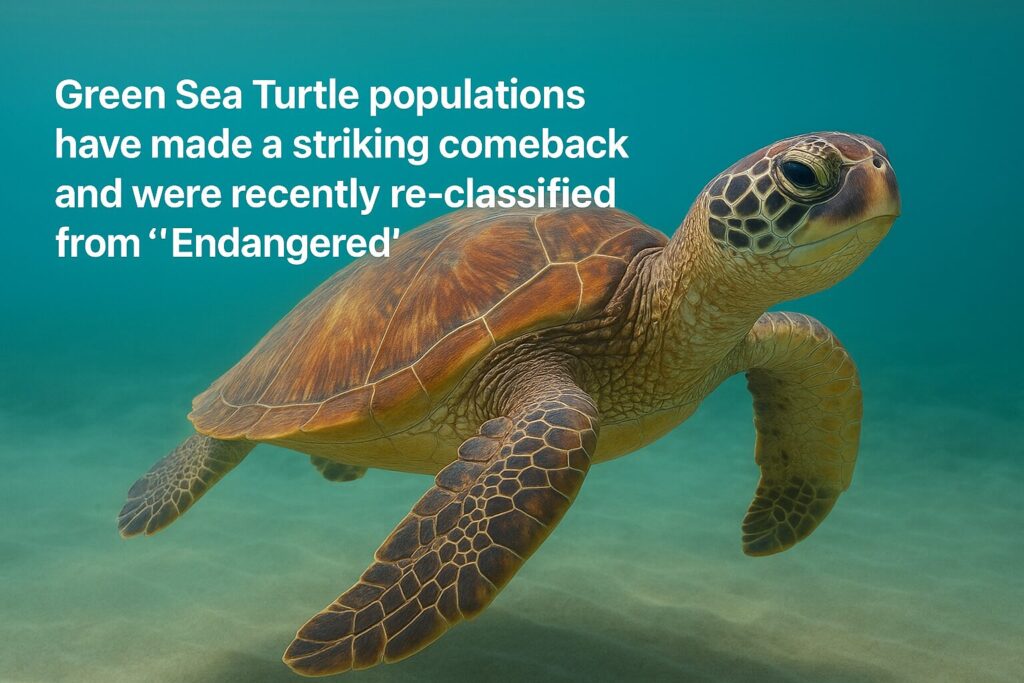How green sea turtles made an incredible comeback (and what it means for other endangered animals)
In a world increasingly dominated by grim environmental headlines, here’s a story that offers genuine hope: green sea turtles have made a remarkable comeback from the edge of extinction. These iconic marine reptiles, beloved by ocean enthusiasts worldwide, are thriving once again in many parts of the world.
The numbers tell an encouraging story. The global population of green sea turtles has increased by 28 percent since the 1970s. The International Union for Conservation of Nature and Natural Resources (IUCN) has reclassified them from “endangered” to “least concern”, a category reserved for species that are plentiful in the wild and not threatened with extinction.
A Dramatic Turnaround
In some regions, the recovery has been nothing short of spectacular. Consider Florida’s Archie Carr National Wildlife Refuge, a protected area along the state’s east coast. In the 1980s, researchers counted only around 40 green sea turtle nests each year in and around the refuge. Today, that number has exploded to more than 20,000 nests annually.
This exponential growth represents one of conservation’s greatest success stories. Scientists measure sea turtle populations by counting their nests on beaches, and these dramatic increases indicate that decades of conservation work are finally bearing fruit.
How We Saved the Green Sea Turtle
What’s most remarkable about this recovery is that it didn’t happen by accident. Green sea turtles rebounded because of deliberate, sustained conservation efforts that addressed the key threats these animals faced.
The first major threat was consumption. Until recently, green sea turtles were harvested extensively for their meat. In the early 20th century United States, turtle soup was a popular dish at inns and festivals. Some turtles weighed over 300 pounds, making them capable of feeding large crowds. Demand was so high that hosts would advertise turtle feasts in newspapers and sell advance tickets.
Even as consumption declined in some countries, other human activities continued to threaten turtle populations. Sea turtles became entangled in fishing nets and drowned. Coastal development destroyed nesting beaches and introduced artificial light that disoriented turtles and their hatchlings, making it harder for them to navigate safely to the ocean.
By the late 1900s, these combined threats had nearly wiped out green sea turtles. The United States granted them federal protection under the Endangered Species Act in 1978, and the IUCN listed them as endangered globally shortly after.
Three Strategies That Worked
Conservation organizations and governments, particularly focused on this charismatic species, implemented three main strategies that proved effective.
First, they protected critical nesting beaches. Florida’s Archie Carr National Wildlife Refuge, established in 1991, limited coastal development and the light pollution that comes with it. This allowed sea turtles to nest without disturbance. Many other nesting beaches in the North Atlantic received similar protection.
Second, conservationists worked with the commercial fishing industry to reduce accidental turtle deaths. Thousands of sea turtles were caught each year in trawl nets targeting shrimp and other seafood. While turtles can hold their breath for several hours, they could still drown if unable to escape. Scientists and fishermen developed “turtle excluder devices”, modifications to trawl nets that give large marine animals an exit route. Regulations also required fishermen to use circle hooks instead of J hooks in some regions, as circle hooks are harder for turtles to swallow.
Third, conservation groups tackled turtle poaching for meat, which remained common in parts of Asia, Central America, and Africa. Rather than simply enforcing bans, successful programs provided alternative income sources to communities that relied on turtle harvesting. In Fiji, for example, people who once collected sea turtle eggs now work with conservation organizations to protect them. They transformed from turtle consumers to turtle protectors.
The Costa Rica Problem
Despite this overwhelming success, the recovery of green sea turtles is far from uniform across the globe. One glaring example highlights how vulnerable these gains remain.
Tortuguero National Park, located along Costa Rica’s northern Caribbean coast, is the second-largest nesting beach for green sea turtles in the world and the largest in the Western Hemisphere. Researchers there used to consistently count more than 100,000 nests each year. Since 2010, however, the population has rapidly declined, with recent years seeing fewer than 50,000 nests.
The culprit? Illegal turtle harvesting in nearby Nicaragua. While people have hunted green sea turtles in Nicaragua for generations, their equipment has become more sophisticated. What was once rustic gear, boats without motors and harpoons, has been replaced with motorized vessels and nets, allowing hunters to catch far more turtles. Although harvesting is illegal in most cases, enforcement remains inadequate. The impact is now clearly visible at Tortuguero.
This stark contrast demonstrates an uncomfortable truth: conservation success often depends on geography and governance. Beaches in countries with stronger legal infrastructure and more funding for conservation, like the United States and Australia, tend to show dramatic recoveries. Populations in regions with weaker enforcement continue to struggle.
Why Haven’t Other Sea Turtles Recovered?
The success of green sea turtles raises an obvious question: what about the six other sea turtle species? Leatherback, hawksbill, and other species remain vulnerable to extinction or critically endangered. Why haven’t they bounced back too?
The answer isn’t entirely clear, but experts suspect several factors. Many green sea turtle nesting beaches happen to be located in countries with resources and political will to protect them. Other species may nest in less protected areas or may spend more time in open ocean waters, where they face greater exposure to fishing operations.
The Threats That Remain
Even as we celebrate this conservation victory, new and ongoing threats loom over sea turtle populations. The same dangers that nearly eliminated them decades ago – fishing gear, habitat destruction, and poaching – persist in many regions.
Newer challenges are emerging as well. Plastic pollution has become a major concern. Millions of tons of plastic waste end up in the ocean each year – bags, bottles, food wrappers, and more. Sea turtles sometimes mistake these items for food or accidentally consume them. Instead of eating squid or crabs, they’re ingesting chunks of plastic. Many turtles are found with dozens of pieces of plastic in their digestive systems, which can be fatal.
Climate change poses another long-term threat. Rising temperatures can affect turtle populations in multiple ways, from altering the sex ratio of hatchlings to destroying nesting habitats through sea-level rise and more powerful storms.
The Long View
There’s another important caveat to this success story: sea turtles are long-lived animals, sometimes reaching 70 years or more. Scientists need to see these positive trends sustained for many more years to truly confirm that green sea turtles have recovered. Short-term population booms can be reversed by new threats or changes in environmental conditions.
Conservation history offers sobering reminders of how quickly gains can be lost. The North Atlantic right whale, for instance, was nearly extinct from hunting by the early 20th century. Long after people stopped killing them for their baleen and blubber, new threats emerged. Ship strikes and entanglement in fishing gear now jeopardize their existence once again.
The lesson is clear: protecting species is never really finished. It requires constant vigilance, adaptation to new challenges, and sustained commitment across generations.
What This Success Teaches Us
Despite these caveats, the recovery of green sea turtles offers valuable lessons and genuine hope for conservation efforts worldwide.
First, it demonstrates that when we commit resources and implement science-based strategies, we can reverse even dire population declines. Species don’t have to be written off as inevitably doomed. Targeted interventions can work.
Second, it shows the importance of addressing multiple threats simultaneously. Protecting nesting beaches alone wouldn’t have been enough if fishing operations continued to kill thousands of turtles each year. Success required a comprehensive approach.
Third, it highlights the value of working with communities rather than against them. Programs that provided alternative livelihoods to turtle hunters proved more effective than enforcement alone. Conservation works best when it accounts for human needs and economic realities.
Finally, this story reminds us that conservation requires patience and persistence. The recovery of green sea turtles didn’t happen overnight. It took decades of sustained effort, involving countless scientists, policymakers, fishermen, and community members working toward a common goal.
Looking Forward
As green sea turtle populations continue to grow in many regions, the challenge now is to maintain and expand this success. That means continuing to protect nesting beaches, keeping fishing regulations in place, supporting communities that have stopped harvesting turtles, and addressing emerging threats like plastic pollution and climate change.
It also means extending successful strategies to other sea turtle species and other threatened animals. The six other sea turtle species desperately need the same level of attention and resources that helped green sea turtles recover.
For those of us watching from the sidelines, this story offers both encouragement and a call to action. It’s proof that environmental decline isn’t inevitable, that with sufficient will and resources, we can restore damaged ecosystems and save species from extinction.
But it’s also a reminder that conservation victories are fragile and must be defended. The work is never done. Every generation must recommit to protecting the natural world and the incredible diversity of life it contains.
The green sea turtle’s comeback from the brink is something to celebrate. It’s also an invitation to do more, for hawksbill turtles, for leatherbacks, for coral reefs, and for countless other species that need our help.
In an era of climate crisis and biodiversity loss, we need these success stories. They remind us what’s possible when we care enough to act. The question now is whether we’ll apply the same dedication and resources to the many other species still waiting for their own comeback story.





